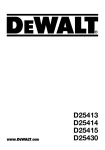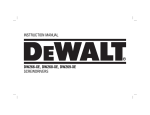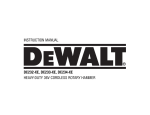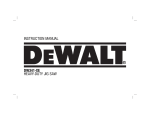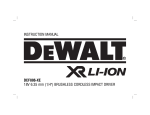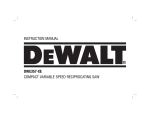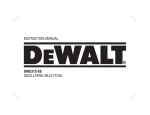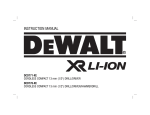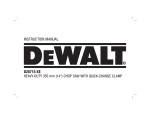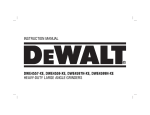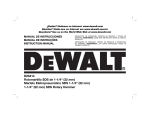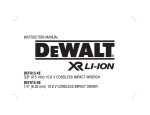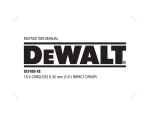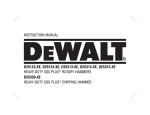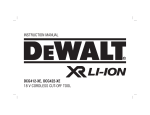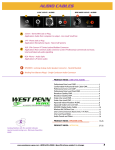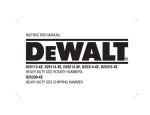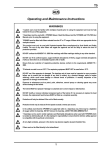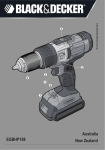Download DeWalt D25414 Instruction manual
Transcript
INSTRUCTION MANUAL D25413-XE, D25414-XE, D25415-XE, D25430-XE 32 mm (1-1/8") HEAVY DUTY ROTARY HAMMER Core drilling capacity in soft brick Tool holder Collar diameter Weight Definitions: Safety Guidelines The definitions below describe the level of severity for each signal word. Please read the manual and pay attention to these symbols. DANGER: Indicates an imminently hazardous situation which, if not avoided, will result in death or serious injury. WARNING: Indicates a potentially hazardous situation which, if not avoided, could result in death or serious injury. CAUTION: Indicates a potentially hazardous situation which, if not avoided, may result in minor or moderate injury. NOTICE: Indicates a practice not related to personal injury which, if not avoided, may result in property damage. LPA (sound pressure) KPA (sound pressure uncertainty) LWA (sound power) KWA (sound power uncertainty) IF YOU HAVE ANY QUESTIONS OR COMMENTS ABOUT THIS OR ANY DEWALT TOOL, CALL US AT: 1800 338 002 (Aust) or 0800 339 258 (NZ). D25413-XE D25414-XE D25415-XE D25430-XE V W min-1 bpm 230 1000 0 – 820 0 – 4700 230 1000 0 – 820 0 – 4700 230 1000 0 – 820 0 – 4700 230 1000 – 0 – 4700 J J 4.2 4.2 4.2 4.2 4.2 4.2 – 4.2 mm 13 / 32 / 32 12 13 / 32 / 32 12 13 / 32 / 32 12 – 12 100 100 mm kg SDS Plus 60 4.2 SDS Plus 60 4.3 SDS Plus 60 4.3 SDS Plus® 60 4.0 dB(A) 86 86 86 86 dB(A) 3 3 3 3 dB(A) 97 97 97 97 dB(A) 3 3 3 3 ® 100 ® – ® Vibration total values (triax vector sum) determined according to EN 60745. Drilling into metal Vibration emission m/s2 <2.5 <2.5 <2.5 value ah = 2 Uncertainty K = m/s 1.5 1.5 1.5 Drilling into concrete Vibration emission m/s2 8.2 8.2 8.2 value ah, HD = 2 Uncertainty K = m/s 1.5 1.5 1.5 Chiseling Vibration emission m/s2 7.1 7.1 7.1 value ah, Cheq = 2 1.5 1.5 1.5 Uncertainty K = m/s Screwdriving without impact Vibration emission m/s2 <2.5 <2.5 <2.5 value ah = 2 1.5 1.5 1.5 Uncertainty K = m/s Technical Data Voltage Power Input No load speed Beats per minute Impact energy Hammerdrilling Chiselling Maximum drilling range in steel/wood/ concrete Chisel positions mm 1 – – – – 7.1 1.5 – – The vibration emission level given in this information sheet has been measured in accordance with a standardised test given in EN 60745 and may be used to compare one tool with another. It may be used for a preliminary assessment of exposure. WARNING: The declared vibration emission level represents the main applications of the tool. However if the tool is used for different applications, with different accessories or poorly maintained, the vibration emission may differ. This may significantly increase the exposure level over the total working period. 1) WORK AREA SAFETY a) Keep work area clean and well lit. Cluttered or dark areas invite accidents. b) Do not operate power tools in explosive atmospheres, such as in the presence of flammable liquids, gases or dust. Power tools create sparks which may ignite the dust or fumes. c) Keep children and bystanders away while operating a power tool. Distractions can cause you to lose control. 2) ELECTRICAL SAFETY a) Power tool plugs must match the outlet. Never modify the plug in any way. Do not use any adapter plugs with earthed (grounded) power tools. Unmodified plugs and matching outlets will reduce risk of electric shock. b) Avoid body contact with earthed or grounded surfaces such as pipes, radiators, ranges and refrigerators. There is an increased risk of electric shock if your body is earthed or grounded. c) Do not expose power tools to rain or wet conditions. Water entering a power tool will increase the risk of electric shock. d) Do not abuse the cord. Never use the cord for carrying, pulling or unplugging the power tool. Keep cord away from heat, oil, sharp edges or moving parts. Damaged or entangled cords increase the risk of electric shock. e) When operating a power tool outdoors, use an extension cord suitable for outdoor use. Use of a cord suitable for outdoor use reduces the risk of electric shock. f) If operating a power tool in a damp location is unavoidable, use a residual current device (RCD) protected supply. Use of an RCD reduces the risk of electric shock. 3) PERSONAL SAFETY a) Stay alert, watch what you are doing and use common sense when operating a power tool. Do not use a power tool while you are tired or under the influence of drugs, alcohol or medication. A moment of inattention while operating power tools may result in serious personal injury. b) Use personal protective equipment. Always wear eye protection. Protective equipment such as dust mask, non-skid safety shoes, hard hat, or hearing protection used for appropriate conditions will reduce personal injuries. An estimation of the level of exposure to vibration should also take into account the times when the tool is switched off or when it is running but not actually doing the job. This may significantly reduce the exposure level over the total working period. Identify additional safety measures to protect the operator from the effects of vibration such as: maintain the tool and the accessories, keep the hands warm, organisation of work patterns. SAFETY INSTRUCTIONS FOR POWER TOOLS When using power tools, always observe the safety regulations applicable in your country to reduce the risk of fire, electric shock and personal injury. Read the following safety instructions before attempting to operate this product. Keep these instructions in a safe place. WARNING: To reduce the risk of injury, user must read the instruction manual. GENERAL POWER TOOL SAFETY WARNINGS WARNING! Read all safety warnings and all instructions Failure to follow the warnings and instructions may result in electric shock, fire and/or serious injury. SAVE ALL WARNINGS AND INSTRUCTIONS FOR FUTURE REFERENCE The term “power tool” in the warnings refers to your mains-operated (corded) power tool or battery-operated (cordless) power tool. 2 c) Prevent unintentional starting. Ensure the switch is in the off position before connecting to power source and/or battery pack, picking up or carrying the tool. Carrying power tools with your finger on the switch or energising power tools that have the switch on invites accidents. d) Remove any adjusting key or wrench before turning the power tool on. A wrench or a key left attached to a rotating part of the power tool may result in personal injury. e) Do not overreach. Keep proper footing and balance at all times. This enables better control of the power tool in unexpected situations. f) Dress properly. Do not wear loose clothing or jewellery. Keep your hair, clothing and gloves away from moving parts. Loose clothes, jewellery or long hair can be caught in moving parts. g) If devices are provided for the connection of dust extraction and collection facilities, ensure these are connected and properly used. Use of dust collection can reduce dust-related hazards. 4) POWER TOOL USE AND CARE a) Do not force the power tool. Use the correct power tool for your application. The correct power tool will do the job better and safer at the rate for which it was designed. b) Do not use the power tool if the switch does not turn it on and off. Any power tool that cannot be controlled with the switch is dangerous and must be repaired. c) Disconnect the plug from the power source and/or the battery pack from the power tool before making any adjustments, changing accessories, or storing power tools. Such preventive safety measures reduce the risk of starting the power tool accidentally. d) Store idle power tools out of the reach of children and do not allow persons unfamiliar with the power tool or these instructions to operate the power tool. Power tools are dangerous in the hands of untrained users. e) Maintain power tools. Check for misalignment or binding of moving parts, breakage of parts and any other condition that may affect the power tool’s operation. If damaged, have the power tool repaired before use. Many accidents are caused by poorly maintained power tools. f) Keep cutting tools sharp and clean. Properly maintained cutting tools with sharp cutting edges are less likely to bind and are easier to control. g) Use the power tool, accessories and tool bits, etc. in accordance with these instructions, taking into account the working conditions and the work to be performed. Use of the power tool for operations different from those intended could result in a hazardous situation. 5) SERVICE a) Have your power tool serviced by a qualified repair person using only identical replacement parts. This will ensure that the safety of the power tool is maintained. Electrical Safety The electric motor has been designed for one voltage range only. Always check that the power supply corresponds to the voltage on the rating plate. 220–240 V AC means your tool will operate on alternating current. Operation at a voltage outside this range can cause loss of power and can result in overheating. All DEWALT tools are factory tested; if this tool does not operate, check the power supply. Your DEWALT tool is double insulated, therefore no earth wire is required. • Young children and the infirm. This appliance is not intended for use by young children or infirm persons without supervision. – This appliance is not intended for use by persons (including children) with reduced physical, sensory or mental capabilities, or lack of experience and knowledge, unless they have been given supervision or instruction concerning use of the appliance by a person responsible for their safety. – Children should be supervised to ensure that they do not play with the appliance. • Replacement of the supply cord. If the supply cord or plug is damaged, it must be replaced by the manufacturer or an authorised DEWALT Service Centre in order to avoid a hazard. Extension Cords CAUTION: Use only extension cords that are approved by the country’s Electrical Authority. Before using extension cords, inspect them for loose or exposed wires, damaged insulation and defective fittings. Replace the cord if necessary. Heavy Duty Rotary Hammer Safety Warnings • Wear ear protectors. Exposure to noise can cause hearing loss. • Use auxiliary handle(s), if supplied with the tool. Loss of control can cause personal injury. 3 • Hold power tools by insulated gripping surfaces when performing an operation where the cutting accessory may contact hidden wiring or its own cord. Cutting accessory contacting a “live” wire may make exposed metal parts of the power tool “live” and could give the opeartor an electric shock. • Use clamps or other practical way to secure and support the workpiece to a stable platform. Holding the work by hand or against your body is unstable and may lead to loss of control. • Wear safety goggles or other eye protection. Hammering operations cause chips to fly. Flying particles can cause permanent eye damage. Wear a dust mask or respirator for applications that generate dust. Ear protection may be required for most applications. • Keep a firm grip on the tool at all times. Do not attempt to operate this tool without holding it with both hands. Operating this tool with one hand will result in loss of control. Breaking through or encountering hard materials such as re-bar may be hazardous as well. • Do not operate this tool for long periods of time. Vibration caused by hammer action may be harmful to your hands and arms. Use gloves to provide extra cushion and limit exposure by taking frequent rest periods. • Do not recondition bits yourself. Chisel reconditioning should be done by an authorized specialist. Improperly reconditioned chisels could cause injury. • Wear gloves when operating tool or changing bits. Accessible metal parts on the tool and bits may get extremely hot during operation. Small bits of broken material may damage bare hands. • Never lay the tool down until the bit has come to a complete stop. Moving bits could cause injury. • Do not strike jammed bits with a hammer to dislodge them. Fragments of metal or material chips could dislodge and cause injury. • Keep the power cord away from the rotating bit. Do not wrap the cord around any part of your body. An electric cord wrapped around a spinning bit may cause personal injury and loss of control. • Do not overheat the bit (discoloration) while grinding a new edge. Badly worn chisels require reforging. Do not reharden and temper the chisel. • Air vents often cover moving parts and should be avoided. Loose clothes, jewellery or long hair can be caught in moving parts. WARNING: We recommend the use of a residual current device with a residual current rating of 30mA or less. WARNING: ALWAYS wear approved protective safety equipment complying with the following standards: • Eye protection: AS/NZS1337 Eye Protectors for Industrial Applications; • Hearing protection: AS/NZS1270 Acoustics – Hearing Protection; • Respiratory protection: AS/NZS1716 Respiratory Protective Devices. WARNING: Some dust created by power sanding, sawing, grinding, drilling, and other construction activities contains chemicals known to cause cancer, birth defects or other reproductive harm. Some examples of these chemicals are: • lead from lead-based paints, • crystalline silica from bricks and cement and other masonry products, and • arsenic and chromium from chemically-treated lumber. Your risk from these exposures varies, depending on how often you do this type of work. To reduce your exposure to these chemicals: work in a well ventilated area, and work with approved safety equipment, such as those dust masks that are specially designed to filter out microscopic particles. • Avoid prolonged contact with dust from power sanding, sawing, grinding, drilling, and other construction activities. Wear protective clothing and wash exposed areas with soap and water. Allowing dust to get into your mouth, eyes, or lay on the skin may promote absorption of harmful chemicals. WARNING: Use of this tool can generate and/or disburse dust, which may cause serious and permanent respiratory or other injury. Always use AS/NZS1716 approved respiratory protection appropriate for the dust exposure. Direct particles away from face and body. WARNING: Always wear proper personal hearing protection that conforms to AS/NZS1270 during use. Under some conditions and duration of use, noise from this product may contribute to hearing loss. • The label on your tool may include the following symbols. The symbols and their definitions are as follows: V ......................volts A .........................amperes Hz ....................hertz W ........................watts 4 min ..................minutes or DC.....direct current ...................Class I Construction (grounded) ...................Class II Construction (double insulated) …/min .............per minute BPM .................beats per minute RPM.................revolutions per minute sfpm ................surface feet per minute DO NOT use under wet conditions or in presence of flammable liquids or gases. These heavy duty rotary hammers are professional power tools. DO NOT let children come into contact with the tool. Supervision is required when inexperienced operators use this tool. or AC ............alternating current or AC/DC......alternating or ...........................direct current no .......................no load speed n .........................rated speed .......................earthing terminal .......................safety alert symbol IPM .....................impacts per minute SPM ....................strokes per minute J F H FIG. 1 A G SAVE ALL WARNINGS AND INSTRUCTIONS FOR FUTURE REFERENCE COMPONENTS (FIG. 1) WARNING: Never modify the power tool or any part of it. Damage or personal injury could result. A. Trigger switch F. Chuck G. Mode selection dial B. Main handle C. Side handle H. Mode selector button D. Depth rod I. Reversing lever (only D25413-XE, D25414-XE & (only D25413-XE, D25414-XE & D25415-XE) D25415-XE) E. Depth rod release button J. Handle shocks INTENDED USE D25413-XE, D25414-XE, D25415-XE These heavy-duty rotary hammers have been designed for professional drilling and hammerdrilling, screwdriving and light chipping. E D B C D25430-XE This chipping hammer has been designed for professional chipping, chiselling and demolition applications. 5 I ADJUSTMENTS Mode Selector (Fig. 3) WARNING: To reduce the risk of serious personal injury, turn tool off and disconnect tool from power source before making any adjustments or removing/ installing attachments or accessories. An accidental start-up can cause injury. NOTICE: Tool must come to a complete stop before activating the mode selector button or damage to the tool may result. DRILL-ONLY MODE (ONLY FOR D25413-XE, D25414-XE & D25415-XE) To use drill-only mode, press mode selector button (H) and turn the mode selection dial (G) so the yellow arrow points to the corresponding G symbol as shown. Use drill-only mode for wood, H metal, and plastics. HAMMERDRILL MODE (ONLY FOR D25413-XE, D25414-XE & D25415-XE) To use hammerdrill mode, press the mode selector button (H) and turn the mode selection dial (G) so the yellow arrow points to the corresponding symbol as shown. Use this mode for masonry drilling. HAMMER-ONLY MODE For light chiseling, press the mode selector button (H) and turn the mode selection dial (G) so the yellow arrow points to the corresponding symbol as shown. NOTE: The yellow arrow on the mode selection dial MUST be aligned with the one of the symbols at all times. There are no operable positions between the positions. E-CLUTCH AND INDICATOR LIGHT (FIG. 4) (D25415-XE ONLY) FIG. 4 The e-clutch offers increased user comfort and safety through an on-board anti-rotation technology capable of detecting if the user loses K control of the hammer. When a jam is detected, the torque and speed are reduced instantly. This feature prevents self rotation of the tool reducing the occurrence of wrist injuries. The red indicator LED (K) lights up the electronic clutch is engaged in any mode except the chipping mode. Side Handle (Fig. 2) WARNING: To reduce the risk of personal injury, ALWAYS operate the tool with the side handle properly installed and securely tightened. Failure to do so may result in the side handle slipping during tool operation and subsequent loss of control. Hold tool with both hands to maximize control. A side handle comes assembled with this rotary hammer. The side handle (C) can be fitted to suit both right-hand and left-hand users. TO ADJUST THE SIDE HANDLE 1. Loosen the side handle (C) by turning it counterclockwise. 2. Rotate the side handle to the desired position. 3. Tighten the side handle by turning it clockwise until you are sure the side handle won’t slip. TO CHANGE SIDES For right-hand users: slide the side handle clamp over the chuck, handle at the left. For left-hand users: slide the side handle clamp over the chuck, handle at the right. FIG. 2 I C Trigger Switch (Fig. 1) To start the rotary hammer, depress the trigger switch (A). To stop rotary hammer, release the switch. The variable speed trigger switch (A) permits speed control. The farther the trigger switch is depressed, the higher the speed of the rotary hammer. NOTE: Use lower speeds for starting holes without a center punch, drilling in metal, plastics or ceramics, or driving screws. Higher speeds are better for drilling in wood and composition board and for using abrasive and polishing accessories. 6 FIG. 3 Proper hand position requires one hand on the side handle (C), with the other hand on the main handle (D). Quick Change SDS Chuck (Fig. 5) (D25414-XE & D25415-XE ONLY) The SDS chuck can be easily removed by turning the collar (L) into the unlocked position to release the chuck. The SDS chuck can be easily attached by inserting the chuck into the spindle of the tool and turning the collar to the locked position. The chuck will click when properly installed. FIG. 5 FIG. 6 C L Inserting and Removing SDS Plus® Accessories (Fig. 1) D WARNING: Burn hazard. ALWAYS wear gloves when changing bits. Accessible metal parts on the tool and bits may get extremely hot during operation. Small bits of broken material may damage bare hands. WARNING: Do not attempt to tighten or loosen drill bits (or any other accessory) by gripping the front part of the chuck and turning the tool on. Damage to the chuck and personal injury may occur. To insert bit, insert shank of bit about 19 mm (3/4"), no further than 7/8" (22 mm) into chuck. Push and rotate bit until it locks in place. The bit will be securely held. To release bit, pull the chuck (F) back and remove the bit. Depth Rod (Fig. 7) (ONLY FOR D25413-XE, D25414-XE & D25415-XE) TO ADJUST THE DEPTH ROD 1. Push in and hold the depth rod release button (E) on the side handle. 2. Move the depth rod (D) so the distance between the end of the rod and the end of the bit equals the desired drilling depth. 3. Release the button to lock rod into position. When drilling with the depth rod, stop when end of rod reaches surface of material. OPERATION FIG. 7 WARNING: To reduce the risk of serious personal injury, turn tool off and disconnect tool from power source before making any adjustments or removing/ installing attachments or accessories. An accidental start-up can cause injury. Proper Hand Position (Fig. 6) WARNING: To reduce the risk of serious personal injury, ALWAYS use proper hand position as shown in Figure 6. WARNING: To reduce the risk of serious personal injury, ALWAYS hold securely in anticipation of a sudden reaction. D 7 E Reversing Lever (Fig. 8) WARNING: Drill may stall if overloaded causing a sudden twist. Always expect the stall. Grip the drill firmly with both hands to control the twisting action and avoid injury. 6. IF DRILL STALLS, it is usually because it is being overloaded or improperly used. RELEASE TRIGGER IMMEDIATELY, remove drill bit from work, and determine cause of stalling. DO NOT CLICK TRIGGER ON AND OFF IN AN ATTEMPT TO START A STALLED DRILL — THIS CAN DAMAGE THE DRILL. 7. To minimize stalling or breaking through the material, reduce pressure on drill and ease the bit through the last fractional part of the hole. 8. Keep the motor running when pulling the bit back out of a drilled hole. This will help prevent jamming. 9. With variable speed drills there is no need to center punch the point to be drilled. Use a slow speed to start the hole and accelerate by squeezing the trigger harder when the hole is deep enough to drill without the bit skipping out. DRILLING IN METAL Start drilling with slow speed and increase to full power while applying firm pressure on the tool. A smooth even flow of metal chips indicates the proper drilling rate. Use a cutting lubricant when drilling metals. The exceptions are cast iron and brass which should be drilled dry. NOTE: Large [7.6 mm to 13 mm mm (5/16" to 1/2")] holes in steel can be made easier if a pilot hole [3.8 mm to 5 mm (5/32" to 3/16")] is drilled first. DRILLING IN WOOD Start drilling with slow speed and increase to full power while applying firm pressure on the tool. Holes in wood can be made with the same twist drills used for metal. These bits may overheat unless pulled out frequently to clear chips from the flutes. For larger holes, use spade bits, power auger bits, or hole saws. Work that is apt to splinter should be backed up with a block of wood. DRILLING IN MASONRY When drilling in masonry, use carbide tipped bits rated for percussion drilling and be certain that the bit is sharp. Use a constant and firm force on the tool to drill most effectively. A smooth, even flow of dust indicates the proper drilling rate. (ONLY FOR D25413-XE, D25414-XE & D25415-XE) The reversing lever (H) is used to reverse the rotary hammer for backing out fasteners or jammed bits in drill-only mode. WARNING: When reversing to clear jammed bits, be ready for strong reactive torque. To reverse the rotary hammer, turn it off and position the reversing lever (H) to the right. To position the lever for forward operation, turn the rotary hammer off and push the reversing lever (H) to the left. FIG. 8 H Drilling (ONLY FOR D25413-XE, D25414-XE & D25415-XE) 1. Always unplug the drill when attaching or changing bits or accessories. 2. Always use sharp drill bits. For WOOD, use twist drill bits, spade bits, power auger bits, or hole saws. For METAL, use steel twist drill bits or hole saws. For MASONRY, such as brick, cement, cinder block, etc., use carbide-tipped bits rated for percussion drilling. 3. Be sure the material to be drilled is anchored or clamped firmly. If drilling thin material, use a wood “back-up” block to prevent damage to the material. 4. Always apply pressure in a straight line with the bit. Use enough pressure to keep drill biting, but do not push hard enough to stall the motor or deflect the bit. 5. Hold tool firmly to control the twisting action of the drill. 8 Cleaning HAMMERDRILL OPERATION 1. When drilling, use just enough force on the hammer to keep it from bouncing excessively or “rising” off the bit. Too much force will cause slower drilling speeds, overheating, and a lower drilling rate. 2. Drill straight, keeping the bit at a right angle to the work. Do not exert side pressure on the bit when drilling as this will cause clogging of the bit flutes and a slower drilling speed. 3. When drilling deep holes, if the hammer speed starts to drop off, pull the bit partially out of the hole with the tool still running to help clear debris from the hole. 4. For masonry, use carbide-tipped bits or masonry bits. A smooth even flow of dust indicates the proper drilling rate. WARNING: Blow dirt and dust out of all air vents with clean, dry air at least once a week. To minimize the risk of eye injury, always wear AS/NZS1337 approved eye protection when performing this. WARNING: Never use solvents or other harsh chemicals for cleaning the non-metallic parts of the tool. These chemicals may weaken the plastic materials used in these parts. Use a cloth dampened only with water and mild soap. Never let any liquid get inside the tool; never immerse any part of the tool into a liquid. Repairs To assure product SAFETY and RELIABILITY, repairs, maintenance and adjustment (including brush inspection and replacement) should be performed by certified service centers or other qualified service organizations, always using identical replacement parts. Chipping and Chiselling (Fig. 1) 1. Set the mode selector switch (G) to the hammering only position. 2. Insert the appropriate chisel and rotate it by hand to lock it. 3. Adjust the side handle (C) as required. 4. Be sure chisel is in contact with work surface before depressing the trigger switch. 5. Always fully release the trigger switch when work is finished and before unplugging. Accessories WARNING: Since accessories, other than those offered by DEWALT, have not been tested with this product, use of such accessories with this tool could be hazardous. To reduce the risk of injury, only DEWALT recommended accessories should be used with this product. Recommended accessories for use with your tool are available at extra cost from your local service center. If you need any assistance in locating any accessory, please contact Stanley Black & Decker, 82 Taryn Drive, Epping, VIC 3076 Australia or call 1800 338 002 or (NZ) 0800 339 258. MAXIMUM RECOMMENDED CAPACITIES Maximum Capacity 1-1/8" (32 mm) Concrete R.P.M. 0–820 (No Load) BITS, Metal Drilling 1/2" (13 mm) Wood, Flat Boring 32 mm (1-1/8") Optimum Capacity 13 to 25 mm (1/2" - 1") Concrete No-load BPM 0-4,700 MAINTENANCE WARNING: To reduce the risk of serious personal injury, turn tool off and disconnect tool from power source before making any adjustments or removing/ installing attachments or accessories. An accidental start-up can cause injury. Brushes DEWALT uses an advanced brush system which automatically stops the drill when the brushes wear out. This prevents serious damage to the motor. New brush assemblies are available at authorized DeWalt service centers. Always use identical replacement parts.Lubrication Your power tool requires no additional lubrication. 9 Stanley Black & Decker 82 Taryn Drive, Epping, VIC 3076 Australia • 1800 338 002 (Aust) or 0800 339 258 (NZ) www.dewalt.com.au • www.dewalt.co.nz (DEC13) Part No. N362624 D25413-XE, D25414-XE, D25415-XE, D25430-XE Copyright © 2013 DEWALT The following are trademarks for one or more DEWALT power tools: the yellow and black color scheme; the “D” shaped air intake grill; the array of pyramids on the handgrip; the kit box configuration; and the array of lozenge-shaped humps on the surface of the tool.













